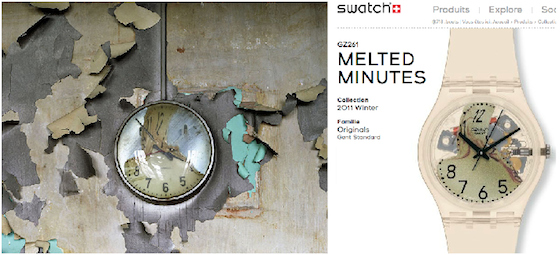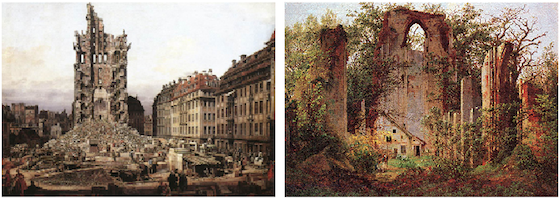
Left: "the Melted Clock" from Cass Technical High School as photographed in 2008 by Meffre/Marchand. Right: the new Swatch 2011 Winter collection "Melted Minutes"
Recently I got an email from Romain Meffre, one of the two French photographers behind the book The Ruins of Detroit. Romain was forwarding me the link to Swatch's 2011 Winter watch collection. I became intrigued by Romain's own surprise: "Look, it's the clock from the old Cass Tech, straight from Detroit to Swatch!"
And there it is... designed by Jeremy Scott (a U.S. designer), mounted in the watch, the famous melted clock! Doing the research I didn't find any reference to Detroit, regarding the intention of the designer. However it's hard not to see more than coincidence here. The watch is called "Melted Minutes"; not sure whether it comes with a framed picture of the old Cass Technical High School (demolished by now).
So, is "ruin porn" hitting the market now? Will we soon see mugs, key chains and the likes, with the Packard or the Fisher body plants on them?
I had met Romain prior to my move to Detroit this summer in order to learn from his experience in Detroit, a city he repeatedly visited since 2005. His work deepened my reflections on the so-called "ruin porn" genre.
I soon came to realize that ruin porn is an expression Detroiters are familiar with, not to mention weary of. The term itself was coined by Vice magazine pointing at those urban explorers and journalists armed with pricy cameras coming to "see" the ruins of Motor city.
There are many issues involved around "ruin porn" and what should be understood as such. It evokes and plays with strong feelings and visuals such as blight, grief, pride, and passion all at once, heating up the debate. Some consider snapping shots of ruins to be exploitative and voyeuristic. Others say one shouldn't be blinded by Detroit boosterism: we have to accept the current face of the city and stop focusing only on the positive aspects. Some hypothesize the end of the industrial civilization, Detroit ruins being the most picturesque embodiment of it. Others think it's purely art and recall memento mori patterns... After all, ruins have been a recurring theme in art, too. Take a look at both of these: on your left, "The Ruins of the Old Kreuzkirche in Dresden" by "il Canaletto," dates back to 1765; on your right, "Kloste Ruine Eldena" by David Caspar Friedrich dates from 1825.

I do understand the fascination for abandoned buildings, I mean, climbing up Michigan Central Station is like realizing your kid's dream, going beyond boundaries and looking for hidden eye-treasures...
Detroit has clearly an amazing array of 20th century buildings; the fact that most of them are left to rot really hurts me, as I'm from Europe, a place where (supposedly) taxpayers' money is used to preserve oldest monuments -- or even rebuild what has been destroyed (like the Old Town in Warsaw, or the Stadtschloss in Berlin). In the D, public money is scarce but the lack of maintenance has also to do with speculation.
Photographing these buildings is totally understandable: even empty and crumbling, they're beautiful. Aesthetically speaking Romain and Yves' pictures are stunning. However all this post-apocalyptic fuss published with little or no explanation and without any more lively picture of Detroit can lead you to think that the city is dead. And hell, no, the D is not a Chernobyl zoo! As rightfully noted on the blog Feministe: there are never any people on these pictures. Yet people do live just next to the Packard plant and some folks have no other choice than "residing" in it. This echoes Patrick Leray's highly recommended Guernica Mag article: "So much ruin photography and ruin film aestheticizes poverty without inquiring of its origins."
We recently followed George, a sociology teacher at Livonia Schoolcraft, and a long-time resident of Midtown. George took a bunch of suburban undergrad students on a field trip to introduce them to the idea of gentrification. As soon as we entered a beautiful abandoned mansion that was obviously being squatted in by homeless people, the kids snapped pics that they'd directly post on their Facebook. It put me very ill at ease but nonetheless shows that what used to be an underground thing (urban exploration) is now just another category of the mainstream culture, the "pseudo underground." By becoming part of the mainstream landscape, ruins are on the verge of losing their meaning, just like with Swatch's watch. But wait a (Swatch!) minute: are the buildings of Detroit actually ruins? Are these comparable to Roman or Greek ruins? Here's another debate within the debate...
But maybe we shouldn't complain when you think about it the interest in Detroit monuments has clearly increased, which gave birth to new publications that are sometimes self-proclaimed antidotes to the Ruin porn movement.
A couple of days ago, a new photography book about the ruins of Detroit got released, although this time each picture is commented by 'city experts' in Julia Reyes Taubman's Detroit: 138 Square Miles. Meanwhile, two other new publications are paying tribute to the richness of Detroit's history by bringing more "flesh" to the city. Amy Elliot Bragg's Hidden History of Detroit as well as John Carlisle's explorations in 313: Life in the Motor City, strangely complete each other. The latest issue of British Boat Magazine (proudly self-labeled "an antidote to lazy journalism") is entirely dedicated to Detroit. Its opening article is signed by Detroiter Jeffrey Eugenides, who repents his previous aesthetic posture in a genuine article untitled "Against Ruin Porn."
Seems we're not yet seeing the end of the debate... In case you didn't have enough reading, check this recent Gallerist NY article that made some buzz in the Detroit websphere: "Panic in Detroit Lures Shutterbugs But How Much Ruin Porn Can We Take?."